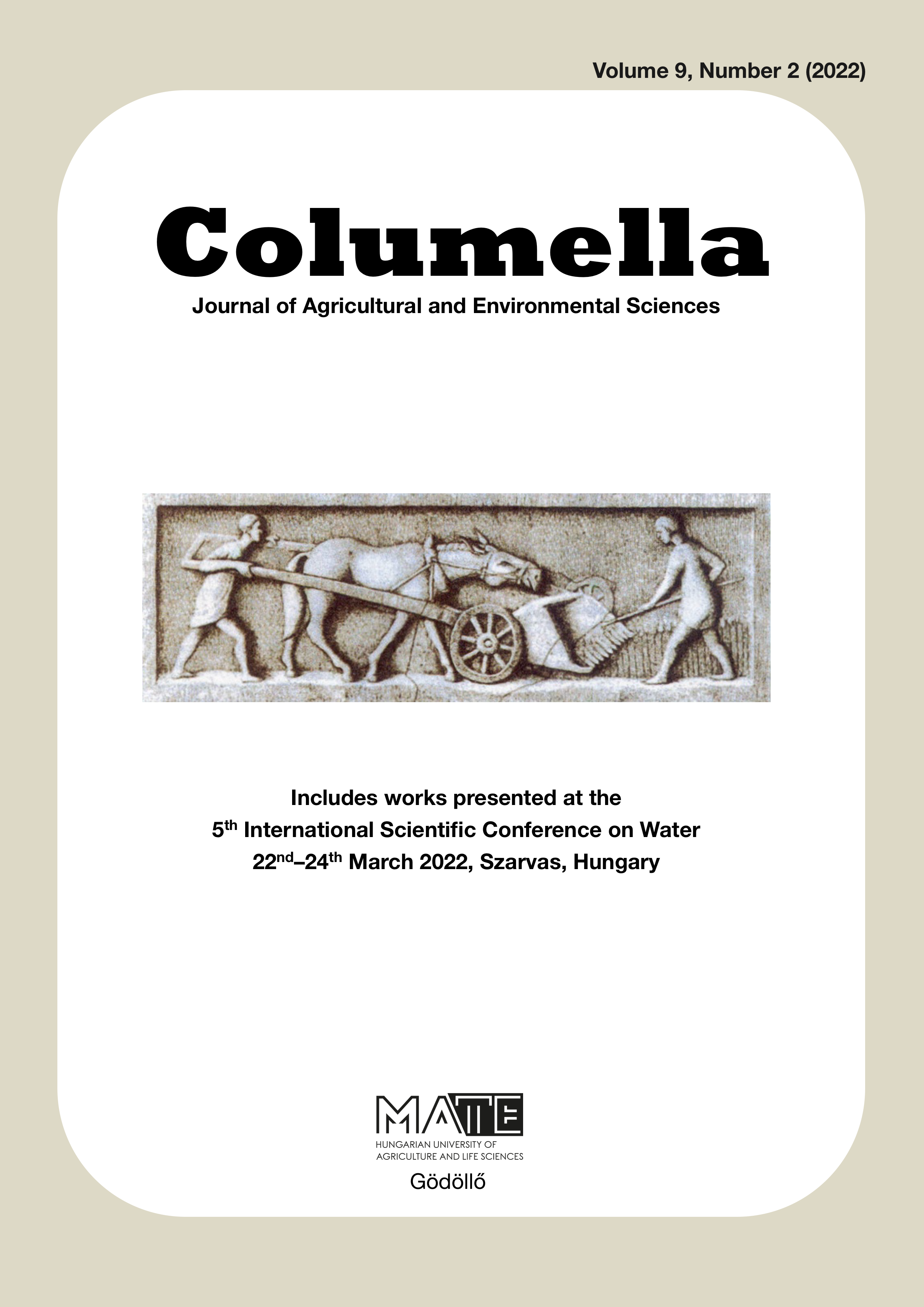Assessment of some morphological and physiological parameters in lettuce (Lactuca sativa l.) cultivated in hydroponic system
DOI:
https://doi.org/10.18380/SZIE.COLUM.2022.9.2.83Abstract
Lettuce is a valuable leaf vegetable for a well-balanced diet, since it is rich in nutrient elements, has low calories and provides dietary antioxidants. Compared to soil-based cultivation, the hydroponic system is an alternative associated with a shortening of growing cycles and a reduction of wasted water amount. The aim of this study was to analyze the growth of lettuce plants under hydroponic and soil cultivation systems, during three phenological growth stages (45; 47 and 49) according to BBCH scale. During the study different morphological and physiological parameters were evaluated: Plant height (PH); Stem diameter (SD); Fresh mass (FM); Dry mass (DM); Leaf area (LA); Chlorophyll content (CC); Transpiration rate (TR). The research was carried out using a complete randomized design with a 2 × 3 factorial arrangement of cultivation system and growth stages. Plants grown in hydroponic system presented higher values of most parameters, except for DM and TR. The cultivation system had the highest effect on PH, SD and LA. The highest variation between growth stages were observed for PH, LA and CC. Finally, we can conclude that lettuce plants cultivated under hydroponic system, presented better growth parameters associated with higher head weight and yield.
References
Amoozgar, A., Mohammadi, A., & Sabzalian, M. R. (2017). Impact of light-emitting diode irradiation on photosynthesis, phytochemical composition and mineral element content of lettuce cv. Grizzly. Photosynthetica 55(1), 85-95. doi: https://doi.org/10.1007/s11099-016-0216-8
Barbosa, G., Gadelha, F., Kublik, N., Proctor, A., Reichelm, L., Weissinger, E., . . . Halden, R. (2015). Comparison of Land, Water, and Energy Requirements of Lettuce Grown Using Hydroponic vs. Conventional Agricultural Methods. International Journal of Environmental Research and Public Health 12(6), 6879-6891. doi: https://doi.org/10.3390/ijerph120606879
Batista, L. A., Guimarães, R. J., Pereira, F. J., Carvalho, G. R., & de Castro, E. M. (2010). Anatomia foliar e potencial hídrico na tolerância de cultivares de café ao estresse hídrico. Revista Ciência Agronômica 41(3), 475-481. doi: https://doi.org/10.1590/s1806-66902010000300022
Carvalho, P. N., Basto, M. C. P., Almeida, C. M. R., & Brix, H. (2014). A review of plant–pharmaceutical interactions: from uptake and effects in crop plants to phytoremediation in constructed wetlands. Environmental Science and Pollution Research 21(20), 11729-11763. doi: https://doi.org/10.1007/s11356-014-2550-3
Chen, X., Xue, X., Guo, W., Wang, L., & Qiao, X. (2016). Growth and nutritional properties of lettuce affected by mixed irradiation of white and supplemental light provided by light-emitting diode. Scientia Horticulturae 200(1), 111-118. doi: https://doi.org/10.1016/j.scienta.2016.01.007
Ciulca, S. (2006). Experimental methodologies in agriculture and biology. Timisoara, Roma- nia: Agroprint.
de Souza, P. F., Borghezan, M., Zappelini, J., de Carvalho, L. R., Ree, J., Barcelos-Oliveira, J. L., & Pescador, R. (2019). Physiological differences of ‘Crocantela’ lettuce cultivated in conven- tional and hydroponic systems. Horticultura Brasileira 37(1), 101-105. doi: https://doi.org/10.1590/s0102-053620190116
Herklotz, P. A., Gurung, P., Vanden Heuvel, B., & Kinney, C. A. (2010). Uptake of human pharmaceuticals by plants grown under hydroponic conditions. Chemosphere 78(11), 1416-1421. doi: https://doi.org/10.1016/j.chemosphere.2009.12.048
Kaiser, C., & Ernst, M. (2012). Hydroponic Lettuce CCDCP-63. Lexington, KY, USA: Center for Crop Diversification, University of Kentucky College of Agriculture, Food and Environment. Lazo, R. P., & Gonzabay, J. Q. (2020). Análisis económico de lechugas hidropónicas bajo sistema raíz flotante en clima semiárido. La Granja 31(1), 118-130. doi: https://doi.org/10.17163/lgr.n31.2020.09
Li, J., Wu, T., Huang, K., Liu, Y., Liu, M., & Wang, J. (2021). Effect of LED Spectrum on the Quality and Nitrogen Metabolism of Lettuce Under Recycled Hydroponics. Frontiers in Plant Science 12(1), 678197. doi: https://doi.org/10.3389/fpls.2021.678197
Llorach, R., Martínez-Sánchez, A., Tomás-Barberán, F. A., Gil, M. I., & Ferreres, F. (2008). Characterisation of polyphenols and antioxidant properties of five lettuce varieties and escarole. Food Chemistry 108(3), 1028-1038. doi: https://doi.org/10.1016/j.foodchem.2007.11.032
Palermo, M., Paradiso, R., Pascale, S. D., & Fogliano, V. (2011). Hydroponic Cultivation Improves the Nutritional Quality of Soybean and Its Products. Journal of Agricultural and Food Chemistry 60(1), 250-255. doi: https://doi.org/10.1021/jf203275m
Paulus, D., Paulus, E., Nava, G. A., & Moura, C. A. (2012). Crescimento, consumo hídrico e composição mineral de alface cultivada em hidroponia com águas salinas. Revista Ceres 59(1), 110-117. doi: https://doi.org/10.1590/s0034-737x2012000100016
Resh, H. (2013). Hydroponic Food Production. Boca Raton, USA: CRC Group ed. Rosa, A. M., Seó, H. L. S., Volpato, M. B., Foz, N. V., Silva, T. C. d., Oliveira, J. L. B., . . . Ogliari, J. B. (2014). Production and photosynthetic activity of Mimosa Verde and Mimosa Roxa lettuce in two farming systems. Revista Ceres 61(1), 494–501. doi: https://doi.org/10.1590/0034-737X201461040007
Senizza,B.,Zhang,L.,Miras-Moreno,B.,Righetti,L.,Zengin,G.,Ak,G.,... Rouphael,Y. (2020). The Strength of the Nutrient Solution Modulates the Functional Profile of Hydroponically Grown Lettuce in a Genotype-Dependent Manner. Foods 9(9), 1156. doi: https://doi.org/10.3390/foods9091156
Sublett, W., Barickman, T., & Sams, C. (2018). The Effect of Environment and Nutrients on Hydroponic Lettuce Yield, Quality, and Phytonutrients. Horticulturae 4(4), 48. doi: https://doi.org/10.3390/horticulturae4040048
Voutsinos, O., Mastoraki, M., Ntatsi, G., Liakopoulos, G., & Savvas, D. (2021). Com- parative Assessment of Hydroponic Lettuce Production Either under Artificial Lighting, or in a Mediterranean Greenhouse during Wintertime. Agriculture 11(6), 503. doi: https://doi.org/10.3390/agriculture11060503
Downloads
Published
Issue
Section
License
Copyright (c) 2022 Dorin Camen, Mihaela Moatar, Adriana Ciulca, Sorina Popescu, Sorin Ciulca

This work is licensed under a Creative Commons Attribution-NonCommercial-NoDerivatives 4.0 International License.






